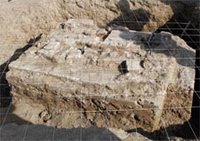Sasanian Column Bases Discovered in Dastwa

LONDON,11 February 2006 (CAIS) -- Archeological excavations in Dastwa (Dastwâ) ancient site near the city of Shushtar in Khuzestan province led to the discovery of 6 Sasanian column bases. “Considering the thickness of each column bases and their distance from one another, it is believed that these 6 discovered brick column bases must have been used in the construction of a hall belonging to the Sasanian dynastic era,” said Mehdi Rahbar, head of excavation team in Dastwa ancient site.
“The column bases are three meters apart from each other. The architectural style and the distance between the column bases indicate the existence of a big roofed hall in this area; however, the usage and the exact date of its construction are not clear yet. Considering the discovery of a Sasanian coin made of lead in the area as well as the architectural style and the size of the column bases, places the hall in the Sasanian dynastic period. Nonetheless, more researches are still required to determine the exact date of the building,” added Rahbar.
Unfortunately, construction of modern fish hatcheries in this area resulted in the destruction of large parts of the architectural remains in Dastwa historical site.
Existence of catacombs, irrigation channels, and various architectural styles in this area, most of which have been destroyed, all give proof to the importance of this giant hall in the ancient times.
“Such an architectural style had already been seen in the other historical sites belonging to the Sasanian period such as Bandian of Dargaz fire temple in Northern Khorassan Province. The only difference is that they were adobe constructed, while the new discovered ones in Dastwa are made of brick,” explained Rahbar.
According to Rahbar, Iran's Cultural Heritage and Tourism Organization has taken the measures to restore the stucco decorations of these column bases to clarify their original designs. Since it is the first time that such stucco decorations are discovered in this historical site, determining their usage would give valuable information about the Sasanian era.
Dastwa city was founded on the basin of Gargar River (the ancient name for Karun River) during the first millennium BC. This historical city was survived during the brutal invasion of Iran by Arabs in 7th century, and it was inhabited until the 9th and 10th centuries AD, before its' gradual abandonment.

0 Comments:
Post a Comment
<< Home